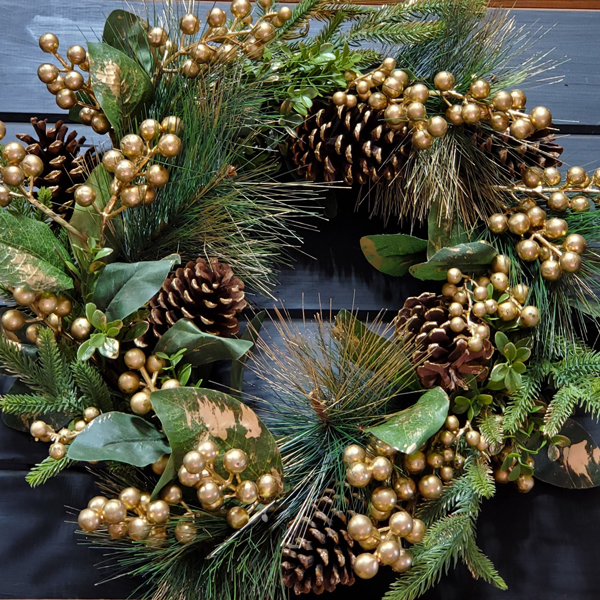Hanging a wreath on a door or a wall is almost as essential to decorating for yuletide as setting up a Christmas tree — and, as it turns out, the two traditions come from the same place.
“The tree gave birth to the wreath,” says Ace Collins, author of Stories Behind the Great Traditions of Christmas.
The custom of bringing evergreens home during the winter began in the 16th century among northern and eastern Europeans — with Germans commonly credited with starting the Christmas tree tradition. During this period, pruning the tree was a part of the preparation process. “Limbs were often cut off in an attempt to make the tree more uniform in shape or to fit into a room,” Collins writes in his book. Instead of throwing the pieces of greenery away, the Europeans wove the excess into wreaths.
“These people were living in a time when everything in their lives was used until it was gone,” Collins tells TIME.
Besides the aesthetic and practical reasons for shaping the tree, there was also a spiritual significance to practice for Christians. “It was important to trim the trees into the shape of a triangle, to represent the Trinity,” Collins says. Catholic legend says that Saint Boniface, a monk from England, used the three points of an evergreen tree to explain the concept of God the Father, Son and Holy Ghost back in the seventh century.
Before the wreath became associated with Christmas, it was a prominent emblem of victory and power in ancient Greece and Rome. In Ovid’s Metamorphoses, after the nymph Daphne rejected the god Apollo and escaped from him by turning into a laurel tree, Apollo says, “Since you cannot be my wife, you shall surely be my tree. O laurel, I shall forever have you in my hair, on my lyre and quiver.” The passage inspired art such as the marble statue “Apollo Crowning Himself,” reinforcing the imagery of Roman and Grecian gods donning the green crown.
The wreath had a similar symbolism among non-deities. Mireille M. Lee, in Body, Dress, and Identity in Ancient Greece, writes, “Athletes who were victorious at the Panhellenic games were crowned with wreaths of olives (Olympia), laurel (Delphi), wild celery (Nemea), and pine (Isthmia).” Outside of competitions, a crown of leaves or flowers also represented honor and joy. The wreath was described as “the ornament of the priest in the performance of sacrifice, of the hero on his return from victory, of the bride at her nuptials, and of the guests at a feast.”
But Christmas wreaths brought a new layer of meaning to the old idea. Such wreaths originally served as Christmas tree ornaments, and not as the standalone decorations we’re familiar with today. They were formed into a wheel-like shape partially for convenience’s sake — it was simple to hang a circle onto the branches of a tree — but the shape was also significant as a representation of divine perfection. It symbolized eternity, as the shape has no end.
Equally important was the material forming the wreaths — the evergreen tree. Evergreen trees were a species looked upon with awe and admiration, since they, unlike most living things, survived the harshness of winter. The trees appeared in abundance in northern and eastern Europe, and people brought them into their homes. “That was a symbol to them of power, of resilience, and in a way, of hope,” Collins says.
Together, the circular shape and the evergreen material make the wreath a representation of eternal life. It is also a representation of faith, as Christians in Europe often placed a candle on the wreath during Advent to symbolize the light that Jesus brought into the world. A German Lutheran pastor named Johann Hinrich Wichern is often given credit for turning the wreath into a symbol of Advent, and lighting candles of various sizes and colors in a circle as Christmas approached.
In that tradition, there are four candles in total— one for each week of Advent. In his book, Collins says that three of the candles, usually purple, represented the Christian values of hope, peace and love. “The final candle, most often red in color, symbolized the joy of new life gained through the gift of Christ’s sacrifice on the cross,” he writes. At times, a white candle was lit on Christmas eve and welcomed Jesus’ birth.
The tradition of the Advent wreath, along with many other Christmas traditions from northern and eastern Europe, was adopted by the masses beginning in the 19th century. Collins says that the marriage of Victoria, Queen of the United Kingdom, to Prince Albert from Germany opened the door for Christmas traditions of other regions in Europe to become popular in England. In turn, British culture influenced American culture. Literature such as Clement Clarke Moore’s A Visit From St. Nicholas also fueled the growth of Christmas traditions such as decorating with wreaths.
Despite its widespread popularity today, the wreath started with humble beginnings. “We live in a throwaway culture,” says Collins. “The wreath was born out of not throwing things away.”
By Kat Moon
Time Magazine
December 21, 2018








